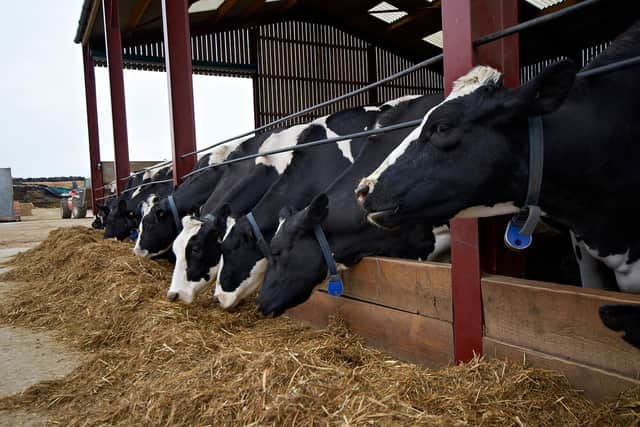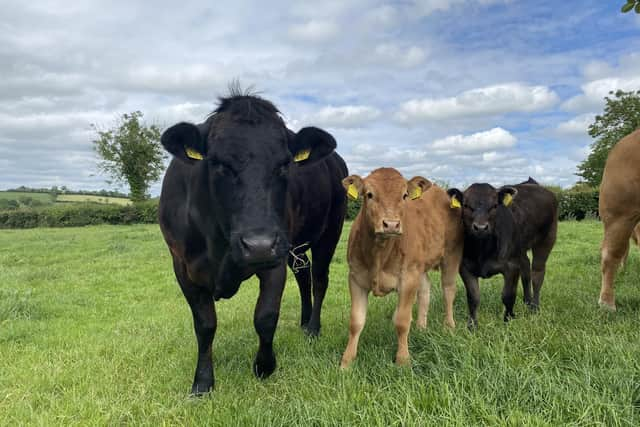Mycotoxins now represent a systemic challenge for livestock farmers in Northern Ireland
and live on Freeview channel 276
What are mycotoxins?
Mycotoxins are natural substances produced by moulds and fungi. They are invisible, tasteless and toxic. More than 500 different mycotoxins have been identified to date, and most animal feedstuffs are likely to be contaminated to some degree. These include grazed grass, conserved forages (silage, wholecrop, maize, straw), homegrown and bought-in feed.
Each plant can be affected by more than one fungus, and each fungus can produce more than one mycotoxin. When multiple toxins are present, they can interact with each other, increasing the chances of synergistic effects. This is when the combined effects of two mycotoxins (even at low levels) are greater than the individual effects of each toxin.


Advertisement
Advertisement
Thoughts were that mycotoxins were a risk if forage was dry or had visible mould. Although this is true, mycotoxins can be present on any forage, of any dry matter, with no visible mould and excellent clamp face management.
They can affect any animal at any stage of production. Problems can be ongoing or flare up suddenly, even on the same pit of silage. This may be due to hitting pockets of mycotoxins in the clamp. Animals may exhibit one symptom or several.
Impact on animals
Mycotoxins can reduce appetite, gut integrity and rumen function, decreasing the animal’s ability to absorb nutrients from feed, resulting in performance losses. Symptoms could be reduced milk yield, fluctuating milk yield, poor milk solids or reduced DLWG. Fluctuating forage intakes, variable dung consistency across a batch of animals or loose dung consistency can also be signs.


They suppress the immune system, which can manifest itself in multiple ways, including cell count problems, from raised SCC to increased cases of mastitis or E. coli, swollen hocks, lameness and rough coats.
Advertisement
Advertisement
Fertility problems can range from irregular heats, cysts, lower conception rates and abortions.
Some can even cause liver damage, kidney damage, internal haemorrhaging and muscle tremors.
What causes mycotoxins?
Field fungi (such as Fusarium sp.) typically occur pre-harvest, and storage fungi (such as Aspergillus and Penicillium sp.) typically occur post-harvest.
Contamination pre-harvest is caused by stress on growing crops. Harsh growing conditions and unfavourable harvesting conditions are becoming more common worldwide due to changeable weather.
Advertisement
Advertisement
Contamination from slurry or farmyard manure on the leaf at the time of ensiling will impact the fermentation process due to the presence of clostridia bacteria. Likewise, soil contamination, of which we are seeing an increasing trend every year, also impacts the fermentation process.
How can we manage mycotoxins?
In the first instance, farmers and contractors should try to limit slurry and soil contamination of all forages.
Injection and trailing shoe applications will also help in this context, and the issue of tedder/rake ground clearance must also be considered. Consolidating the clamp well throughout ensiling is also advised.
Post-harvest mycotoxins can be caused by poor consolidation and clamp management but are easier to manage. Remove any visible mould from the clamp and do not feed to any animals.
Advertisement
Advertisement
If mould is mixed in the TMR, it could cause mycotoxins to multiply. Problem areas tend to be down the sides and along the top of the clamp, but mycotoxins are certainly not confined to these areas alone.
Limiting the amount of time forage is exposed to oxygen reduces the chance of mycotoxin development. Only remove covers at the point of feeding, aim to move across the face as quickly as possible and, if needed, take half blocks. So, using a sharp shear grab/block cutter to keep the face as clean and even as possible is strongly advised.
Mycotoxins are everywhere
You may not be able to see the moulds that produce mycotoxins in grass silage. The fact is that many of these organisms are invisible to the naked eye.
But if they are ‘in situ’ then they may well be impacting on both the nutritional value of your forages and the actual health status of your stock.
Advertisement
Advertisement
These were just some of the key messages delivered by Alltech’s regional manager for Northern Ireland, Richard Dudgeon, courtesy of his presentation to the company’s recent “Making Silage Sense’ webinar. The event focussed on the ways by which farmers can minimise forage losses at feed-out.
Richard explained: “Mycotoxins are everywhere. Yes, they can be in forages. However, they will also be present in grains and they can be in straw.
“Mycotoxins will be produced when a mould comes under stress. So we can end up with a situation whereby a large mould population will not be generating significant quantities of mycotoxins at all while, in other instances, an extremely low population of moulds will be generating very large quantities of mycotoxins.”
According to the Alltech representative, a number of factors can influence the presence of mycotoxins within feeds. These include the weather.
Advertisement
Advertisement
“We are starting to see more extreme weather events,” Dudgeon continued.
“Min-till methods can also predispose crops to mycotoxins while harvesting dates, crop type, and herbicide control measures are also factors in this regard.
“Crop storage conditions are also critical when it comes to determining the presence of mycotoxins. This is particularly so, where silages are concerned.”
Adding to the mycotoxin burden on Irish farms are the heightened level of grain and forage imports coming into this country from other parts of the world.
Advertisement
Advertisement
Richard Dudgeon again:“There is also a growing awareness at farm level as to the threat posed by mycotoxins. As a result, the issue is more widely discussed across the various agri sectors.
“In part, this has been facilitated by the significant amount of mycotoxin-related research that has been carried out by companies like Alltech.
“Our ’37+ laboratories are based in the US and at Dunboyne in Co Meath. They are independently accredited centres of excellence, where mycotoxin research is concerned.”
Currently, Alltech can test for 54 mycotoxins. This work also encompasses the compilation of a comprehensive report on the impact these substances can have when found in grains and forages.
Advertisement
Advertisement
Over the past 12 months, Alltech has tested 94 forage, TMR and raw material samples for the presence of mycotoxins. These were submitted from dairy farms located throughout the UK and Ireland.
Richard Dudgeon again:“On average there have been 4.2 mycotoxins identified per sample. Moreover, 97% of the samples submitted contained at least two mycotoxins.
“We were also able to predict the impact these mycotoxins would have on animal performance.
“So, for example, the work carried out confirmed that milk output would be impacted by an average of 0.6L/cow per day and that cell counts would rise by around 20%, simply by feeding a cross section of the feed submitted for analysis..
Advertisement
Advertisement
He concluded:“Penicillium mycotoxins predominated within the Irish samples that we analysed over the past 12 months. These are storage-related substances.
“Clamp management and the fermentation pathways followed in the pit will determine the level of these mycotoxins found in forages.
“Because this is a storage-related issue, it is possible to hit very large quantities of Penicillium mycotoxins within a clamp very easily.
“Poor face management and heat generation within a clamp are all stress points for moulds that lead to the production of these mycotoxins.
Advertisement
Advertisement
“Specifically, where dairy is concerned, the presence of mycotoxins in a feed can lead to a range of animal health and production related problems.”
Richard went on to confirm that Alltech have developed a number of bespoke, in-feed mycotoxin binders, produced from yeast cell walls.
Mycotoxins and clamp slippages
Renowned silage specialist Dr Dave Davies has confirmed that clamp slippage and mycotoxin-related problems were a significant challenge on livestock farms in Northern Ireland throughout the 2021/22 feeding season.
Earlier this year, he visited dairy farms, across a number of counties, where such problems had arisen.
Advertisement
Advertisement
Davies’ investigation work included the identification of specific moulds and related toxins plus a physical examination of clamps to identify the factors that had led to specific slippage problems occurring.
The silo inspections entailed the determination of forage density measurements throughout the clamps under investigation.
Silage temperatures were also measured at various points and depths on some of the open clamp faces where it was deemed there was a problem in this regard.
The clamps investigated contained a mix of single and multiple silage crops. Cutting dates varied across the spring and summer months of 2021. A range of inoculants had been included with the forages at time of ensiling.
Advertisement
Advertisement
With regard to slippages, Davies ascertained that differences in silage densities were at the heart of the problem.
Contributory factors here include the production of low dry mater silages and the fact that water, if allowed to get into a clamp, gravitates towards the bottom layers of forage over a relatively short period of time.
Davies confirmed that slippages are prone to take place when higher density forages rest on the top of a clamp.
In such instances, the poorer density forages below gives way due to the higher weight above it. This is more likely to occur with high quality and lower dry matter silages.
This is partly because there is less fibre in the grass.
Advertisement
Advertisement
Temperature investigations of the various clamps also proved insightful. In one case a temperature of 41 °C was identified. According to Davies, clamp heating of this nature is caused by forages being exposed to excessive oxygen at feed-out.
Such conditions will also encourage the growth of moulds and the subsequent production of mycotoxins.
The list of mycotoxins identified by Davies included: Type B Trichothecenes; Fusaric Acid; a range of other Peniccillium toxins and other toxins.
Reviewing the work undertaken David Davies commented: “Feed out losses can be extremely costly. I am also aware that clamp slippage is a major issue in Ireland this year.”
Advertisement
Advertisement
According to the silage specialist, even when silage clamp management is at extremely high levels, there will always be a 10% nutrient loss between filed and feed out.
Feed out losses are caused by aerobic organisms. And in grass silages, it is yeasts and moulds that are most important.
“Moulds have the potential to produce mycotoxins,” Davies explained.
“But they will also act to reduce forage quality.
“There will also be variability in forage quality across a clamp face.”
Advertisement
Advertisement
He added that this can relate to crop density, plus ME and protein values.
“So, for farmers feeding forage on the basis of what’s contained within a silage grab, the nutritional value of the feed offered to stock can vary on an almost daily basis,” Dr. Davies said.
“Knowing the variability in a silage clamp is very important; this information allows for the management of a clamp to be undertaken in ways that minimise these differences.”
David Davies went on to point out that top waste is a key feature of silage clamps in high rainfall areas.
“This top waste must be removed as otherwise, the toxins contained within can seep down to the better-quality forage that is located below it,” he continued.